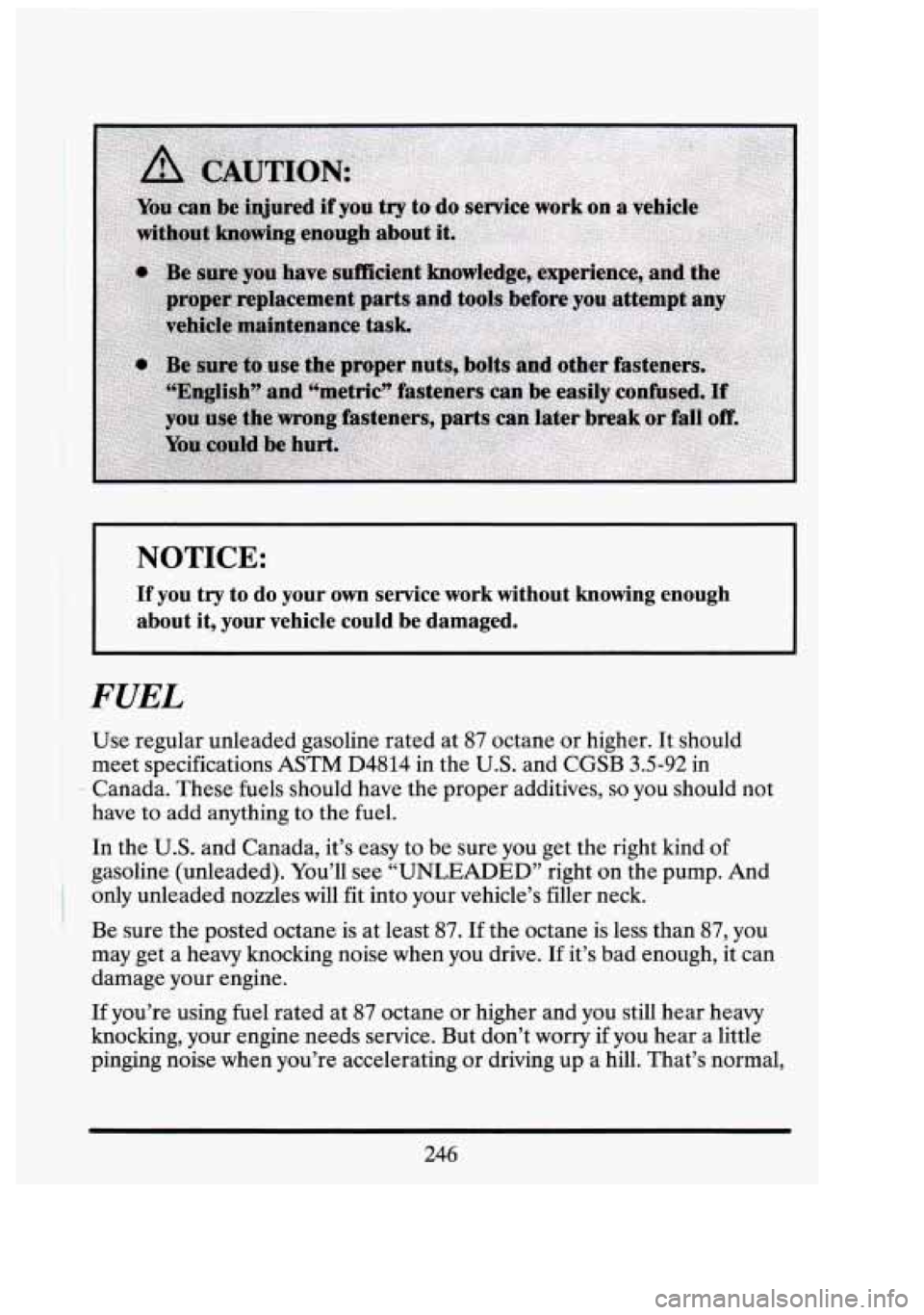Page 157 of 398
FUEL GAGE
Your fuel gage shows
about how much fuel is
in your tank.
It works only when the ignition is in the “RUN” position. The 17 bar
segments show the fuel remaining in your tank.
>When only one bar segment still is lit, the
“LOW FUEC‘ light will go on.
‘If the fuel supply gets critically low, none of the bar segments will be lit
and the “LOW FUEC’
will flash. You should get fuel immediately.
Here are a few concerns some owners have had about the fuel gage. All
.these situations are normal and indicate nothing wrong with the fuel
>gage-
The pump at the gas station shuts off before the fuel gage reads “F”.
It takes more (or less) gas to fill up than the gage said. For example,
the gage said
“l/2”, but it took more or less than half the tank capacity
to
fill it.
The gage changes when you turn (or stop, or speed up).
13
C
Ql
C’
i
I
144
..
Page 259 of 398

NOTICE:
If you try to do your own service work without knowing enough
about it, your vehicle could be damaged.
I
FUEL
Use regular unleaded gasoline rated at 87 octane or higher. It should
meet specifications
ASTM D4814 in the U.S. and CGSB 3.5-92 in
have to add anything to the fuel.
In the U.S. .and Canada, it’s easy to be sure you get the right kind of
gasoline. (unleaded). You’ll see “UNLEADED” right.
on the pump. And
Be sure the posted octane is at least
87. If the octane is less than 87, you
may get a heavy knocking noise when you drive. If it’s bad. enough, it can
damage your engine.
‘1 Canada. These fuels should have the proper additives, so you should not
I ’ only unleaded nozzles will fit into your vehicle’s filler neck.
i
If you’re using fuel rated at 87 octane or higher and you still hear heavy
knocking, your engine needs service. But don’t worry if you hear a little
pinging noise when you’re accelerating or driving up a. hill. That’s normal,
246
op
3’
-’ I
I n
Lll
“I
I -1
I
r7
Page 328 of 398

FUSE USAGE CHART
0
FOR MORE INFORMATION, SEE OWNER’S MANUAL
UNDERHOOD (U/H) ELECTRICAL CENTER BODY 1 (SO AMP)
I/P FUSE BLOCK
#3 PWR. SEAT CIRCUIT
BREAKER (30 AMP)
#36 TRUNK PULL-DOWN
#37 HAZARD LTS. (20 AMP)
(15 AMP)
#39 PWR. LUMBAR (20 AMP)
#40 HEATED SEAT (20 AMP)
#44 STOP LTS. (20 AMP)
#45 PWR. LOCK (20 AMP)
BODY 2 (50 AMP)
I/P FUSE BLOCK
- #21 RAP BAT (25 AMP)
- #22 HVAC MDL. (25 AMP) - #26 ELC. SENS. (20 AMP) - #27 D/INT LTS. (1 5 AMP) - #28 FRT CIG. (1 0 AMP) - #29 RR. CIG. (20 AMP) - #30 EBTCM (25 AMP) - #33 HVAC BAT (10 AMP) - #34 CCM BAT (10 AMP) - #35 PWR. MIR. (10 AMP) - #2 CIRCUIT BREAKER - RAP RLY (30 AMP) 3 - ION 1 (50 AMP) - I/P CONCEALED FUSE - RKE/UTD SA - I/P FUSE BLOCK - #6 T/SIS-ICA - #7 EBTCMDPS (1 0 AMP) - #8 RAP WPR. (25 AMP)
- #10 WIPER (25 AMP) - #9 RADIO (10 AMP)
- #li I/P IiDC (10 AMP) - #12 ELC. IGN. 1 (10 AMP) - #13 CHIME (10 AMP) - #14 CCM IGN 1 (10 AMP) - #15 AIR BAG (1 5 AMP) - #24 STARTER, U/H ELC. CNTR. - #15 PCM/IGN (10AMP) - #16 INJ 1 (10AMP) - #17 EMISSIONS (1 0 AMP) - #18 INJ 2 (10 AMP) 4 - ION 3 (40 AMP)
I/P FUSE BLOCK
- #16 GEN. (10 AMP) - #17 MEM. SEAT (10 AMP) - #18 CCM IGN 3 (10 AMP) - #19 RAP PWR. (30 AMP) - #20 A/C COMF! (10 AMP) - #25 HVAC IGN (10 AMP)
- BRAKE PRESSURE 5 - ABSRC (60 AMP)
MODULATOR VALVE (BPMV) 6 - NOT USED 7 - SCNDRY CLG FAN (40 AMP) - SECONDARY COOLING FAN
CNTRL. RELAY
8 - PRIMRY CLG FAN (40 AMP) - PRIMARY COOLING FAN
9 - LEVEL CNTRL. (30 AMP) CNTRL. REIAY
- AUTOMATIC LEVEL CNTRL.
10 - ENGINE (30 AMP) AIR COMR
- #13 PCM/FUEL PUMP (15 AMP) - #14 AIR PUMP (20 AMP)
11 - I/P FUSE BLOCK CIRCUIT
BREAKER
- #5 HDLTS (20 AMP) - #31 PARK LTS. (20 AMP) - #32 HORN (25 AMP) 12 - EMPTY 13 - PCM FUEL PUMP 115 AMP) - FUEL PUMP RELA? - FUEL PUMP AND ENGINE OIL PRESSURE INDICATOR SWITCH
MDL (PCM) - POWER TRAIN CONTRL.
14 - AIR PUMP (20 AMP) - SECONDARY AIR IN (AIR)
PUMP RELAY
15 - PCM IGN (10 AMP) - IGN COIL - ELECTRONIC TRANS. - (PCM) POWER TRAIN
CNTRL. MDL.
16- INJ 1 110AMP) ~ - FUEL I‘NJ 1,4,6,7 17 - EMISSIONS (10 AMP) - (A.I.R.) PUMP‘RELAY . - MASS AIR FLOW (MAF)
- HEATED OXYGEN SENSOR’S - EVAPORATIVE EMISSIONS
SENSOR
CANNISTER PURGE
SOLONOID VALVE
18- INJ 2 (10 AMP) - FUEL INJ 2,3,5,8
315